An interview with Jodi Rowley, a part of our on-going Interviews with Young Scientists series.
![></img>One of Jodi Rowley’s new discoveries: the vampire flying frog (Rhacophorus vampyrus). Photo by: Jodi J. L. Rowley/Australian Museum. ” ><br></br><i>One of Jodi Rowley’s new discoveries: the vampire flying frog (</i>Rhacophorus vampyrus<i>). Photo by: Jodi J. L. Rowley/Australian Museum. </i><br></br>
<BR><BR></p>
<p>In 2009 researchers discovered 19,232 species new to science, most of these were plants and insects, but 148 were amphibians. Even as amphibians face unprecedented challenges—habitat loss, pollution, overharvesting, climate change, and a lethal disease called chytridiomycosis that has pushed a number of species to extinction—new amphibians are still being uncovered at surprising rates. One of the major hotspots for finding new amphibians is the dwindling tropical forests of Southeast Asia.<br></br>
<BR><BR><br></br>
“Southeast Asian amphibians are poorly known—new species are continuously being discovered and for the species that we do know of, we don’t know enough about many of them to know if they’re threatened with extinction or not […] Because we don’t yet know the true diversity or conservation status of Southeast Asian amphibians, they’ve tended to slip under the global conservation radar,” Jodi Rowley, herpetologist with the Australian Museum in Sydney, told mongabay.com in a recent interview. Rowley, who only received her PhD in 2007, has already helped describe ten new species, including a frog that chirrups like a bird and another that is evocatively named the vampire flying frog.<br></br>
<BR><BR><br></br>
“Its unusual name is for a good reason though—the tadpoles of the species are truly bizarre. With two, curved, black ‘fangs’ protruding from their mouth in place of the usual tadpole mouthparts, I think it deserves the name and the attention! There’s no doubt a fascinating reason for these teeth—and we’re working on discovering that,” explains Rowley.<br></br>
<BR><BR><br></br>
The best place to discover new amphibian species in Southeast Asia are high-altitude montane forests. Rowley says there is a number of reasons for this: “Montane forests are areas of high amphibian diversity. They’re also areas of high endemism—over time, frogs on mountains often become ‘trapped,’ unable to cross valleys to reach the next mountain, and become different species—those adapted to the unusually cool, wet conditions found at the top of mountains. The inaccessibility of montane areas (rugged terrain in remote areas) has also afforded the forest in these areas some protection from habitat destruction.”<br></br>
<BR><BR></p>
<table align=right>
<tr>
<td width=20></td>
<td width=360><font size=1><br></br>
<img src=https://photos.mongabay.com/j/interview.rowley.DSC_2491.360.jpg width=360 alt=](https://photos.mongabay.com/j/Rhacophorus_vampyrus.568.jpg)
Amolops tuberodepressus, a frog species endemic to China. Only discovered in 2000, it is listed as Vulnerable by the IUCN Red List. Photo by: Jodi J. L. Rowley/Australian Museum.
With the paucity of knowledge on Southeast Asia’s amphibians, scientists know less about their overall conservation status as compared to amphibians in Africa and Latin America. However, given that Conservation International has dubbed Southeast Asia’s tropical forests the most imperiled in the world, it’s likely that many of the region’s amphibians are struggling to survive.
“By far the greatest threat to amphibians in Southeast Asia is habitat loss,” says Rowley. “While some amphibians are able to persist in human-modified habitats such as pastures, rice-paddies and even cities, most simply can’t tolerate much habitat modification at all. For example, many amphibians are almost completely arboreal, even breeding in water-filled pools in trees. Without a healthy forest with lots of ‘holey’ trees, there’s no way they can survive.”
Southeast Asia’s amphibians also face threats from overcollection for food, medicine, and the pet trade. The devastating chytridiomycosis could become a major issue as well, though to date there’s no sign of an outbreak similar to that which has occurred in the New World tropics.
“We know that the pathogen responsible for the disease, Batrachochytrium dendrobatidis, is present and infecting amphibians in Southeast Asia, but we don’t know if it’s actually causing disease (eg. making the frogs sick) or affecting the populations of amphibians in the region,” explains Rowley. “So far, there’s no evidence that it is, but a lot more research is needed to determine if this is the case. […] We’re currently hoping that Southeast Asian amphibians are somehow resistant.”
Rowley, who works with students in Southeast Asia, says one of the keys to getting students interested in conservation is simply getting them into the field.
“Often students just haven’t spent much time in the forest, and haven’t realized how amazing amphibians are—so the first step is just getting students into the forest, and hopefully they’ll fall in love with the place and the creatures within on their own.”
In a February 2012 interview Jodi Rowley discussed the process of discovering new species, why Southeast Asia remains a hotspot for undescribed amphibians, and the myriad threats facing the region’s frogs.
INTERVIEW WITH JODI ROWLEY
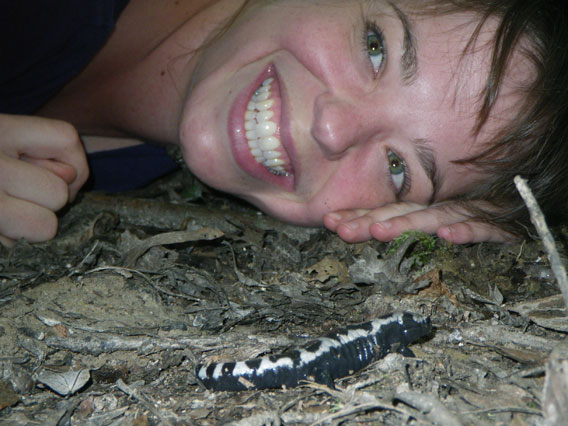
Jodi with salamander. Photo by: Jodi J. L. Rowley/Australian Museum.
Mongabay: What led to your interest in amphibians?
Jodi Rowley: Growing up I loved nature, but hadn’t really had any experience with amphibians. As a child, I don’t really recall ever catching tadpoles or seeing frogs hopping around. I was a city kid. It wasn’t until I started a university degree (in environmental science) that I became fascinated by amphibians. My initial volunteering on frog surveys rapidly turned into a passion for amphibians, and a career!
THE AMPHIBIANS OF SOUTHEAST ASIA
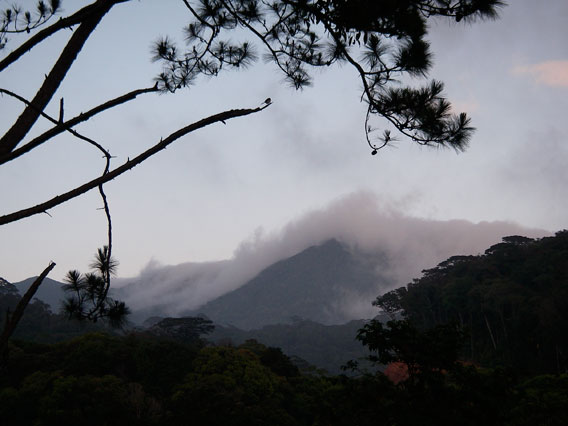
Lang Bian cloud forest in Vietnam. Photo by: Jodi J. L. Rowley/Australian Museum.
Mongabay: Why do you think amphibians in Southeast Asia have been overlooked compared to other hotspots?
Jodi Rowley: Southeast Asian amphibians are poorly known—new species are continuously being discovered and for the species that we do know of, we don’t know enough about many of them to know if they’re threatened with extinction or not. In fact, 36 percent are so poorly known that they are listed as “Data Deficient” according to the global IUCN Red List, which is 11 percent higher than the global average for amphibians. Because we don’t yet know the true diversity or conservation status of Southeast Asian amphibians, they’ve tended to slip under the global conservation radar. However, the fact we don’t know enough about what is going on is alarming in itself—there’s actually very good reasons to be concerned about Southeast Asian amphibians.
Mongabay: Amphibians worldwide are undergoing an extinction crisis, how are those in Southeast Asia faring so far?
Jodi Rowley: Southeast Asian amphibians are facing some serious threats—including the highest deforestation rates on the planet and overharvesting (for food, pets or traditional medicine). They’re also now known to be infected by the pathogen responsible for amphibian declines and extirpations globally (Batrachochytrium dendrobatidis). So by all accounts, they are facing a very real extinction crisis. However, because we know so little about the amphibians of the region, and haven’t been monitoring populations all over the region, amphibian population declines and extinctions may be going unnoticed.
Mongabay: What are the major threats to amphibians in Southeast Asia?
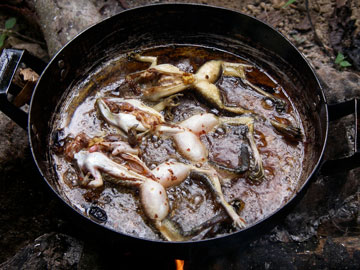 Frogs as food in Vietnam. Photo by: Jodi J. L. Rowley/Australian Museum. |
Jodi Rowley: By far the greatest threat to amphibians in Southeast Asia is habitat loss. While some amphibians are able to persist in human-modified habitats such as pastures, rice-paddies and even cities, most simply can’t tolerate much habitat modification at all. For example, many amphibians are almost completely arboreal, even breeding in water-filled pools in trees. Without a healthy forest with lots of “holey” trees, there’s no way they can survive.
Mongabay: What are amphibians harvested for in Southeast Asia?
Jodi Rowley: Amphibians are harvested for food (either to feed people or animals), for use as traditional medicine, and for the domestic and international pet trade. Harvesting amphibians for food is on a much greater scale than the other two, and there’s evidence that over-harvesting for human consumption may be threatening long-lived and large-bodied frogs—they seem to be absent in areas where they were once abundant. The harvesting and trade of Southeast Asian salamanders is also very worrying. Salamanders in the region are used as traditional medicine and are in high demand in the international pet trade. Because very high prices are commanded for each individual (up to several hundred U.S. dollars), particularly if they belong to a rare species, there’s incentive to catch every last one.
Mongabay: Is the fungal disease, chytridiomycosis, an issue in Southeast Asia? If not could it become one?
Jodi Rowley: We know that the pathogen responsible for the disease, Batrachochytrium dendrobatidis, is present and infecting amphibians in Southeast Asia, but we don’t know if it’s actually causing disease (eg. making the frogs sick) or affecting the populations of amphibians in the region. So far, there’s no evidence that it is, but a lot more research is needed to determine if this is the case. If it is causing population declines as it has in other parts of the world, then the disease could quickly become the greatest threat facing amphibians in Southeast Asia—potentially wiping out the amphibian species that have been spared from habitat loss. We’re currently hoping that Southeast Asian amphibians are somehow resistant.
NEW SPECIES ABOUND
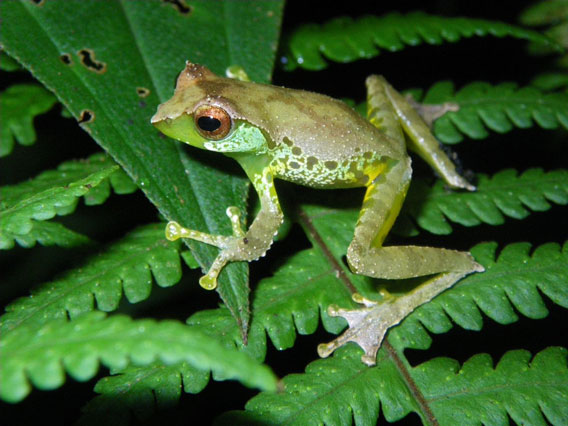
The male Quang’s tree frog has uniquely complex vocalizations. Photo by: Jodi J. L. Rowley/Australian Museum.
Mongabay: How many new species have you been involved in discovering?
Jodi Rowley: So far, my colleagues and I have discovered and described ten species of frog. The actual discovery—spotting the frog and realizing that it’s from a species not known to science—is fantastic, but brief. Most of the work actually occurs once we are back in the lab—comparing the body size and shape, and colors and patterns on the frog to other species known from the region, and examining molecular data and advertisement call recordings.
Mongabay: Does one in particular stand out?
Jodi Rowley: I have a particular fondness for the vampire flying frog (Rhacophorus vampyrus). It’s also been the species that has received the most attention. Its unusual name is for a good reason though—the tadpoles of the species are truly bizarre. With two, curved, black “fangs” protruding from their mouth in place of the usual tadpole mouthparts, I think it deserves the name and the attention! There’s no doubt a fascinating reason for these teeth—and we’re working on discovering that. The frog itself is also quite a beautiful species—brick red, black and white, with large, golden eyes.
Mongabay: What makes Quang’s tree frog so unusual?
Jodi Rowley: Quang’s tree frog is unique in its tiny size, turquoise skin and black and yellow patterns, but it’s most unusual because of its call. Instead of calling repeatedly “croak, croak, croak…” as most frogs tend to do, males of this species make an unpredictable and variable array of clicks and whistles. No two of calls are the same—making it a little more like a bird than a frog in terms of calls.
Mongabay: Why do you mostly target montane forests for undiscovered species?
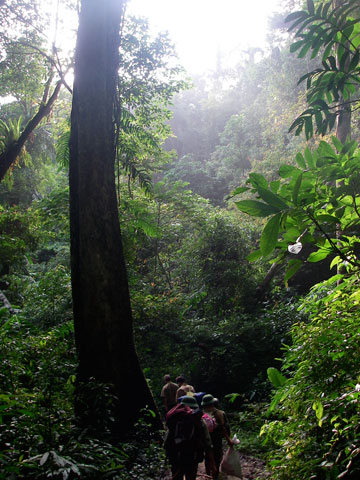 Hiking through the forests of Vietnam. Photo by: Jodi J. L. Rowley/Australian Museum. |
Jodi Rowley: Montane forests are areas of high amphibian diversity. They’re also areas of high endemism—over time, frogs on mountains often become ‘trapped,’ unable to cross valleys to reach the next mountain, and become different species—those adapted to the unusually cool, wet conditions found at the top of mountains. The inaccessibility of montane areas (rugged terrain in remote areas) has also afforded the forest in these areas some protection from habitat destruction. The more easily accessible lowland forests of Southeast Asia have fared much worse.
Mongabay: Given how many new species you’ve been involved with discovering, does it ever start to feel routine?
Jodi Rowley: Discovering a new species could never be routine!
Mongabay: How many new amphibians do you think could still be hiding in Southeast Asia?
Jodi Rowley: A large proportion of the amphibians in Southeast Asia remain undiscovered. Exactly how many, I’m not sure. Looking at how many new species of amphibian are described from Southeast Asia every year, there’s still a lot to discover.
Mongabay: You’ve been to some pretty wild and remote places in search of amphibians. Do you have a favorite? Why?
Jodi Rowley: I have a few favorite places, and each of these places are special for different reasons. Because it’s the place that I have been back to the most, I do love the Langbian Plateau in southern Vietnam. The amphibians of the area are diverse, and many are known only from the Plateau’s misty mountains. I’ve also worked with protected areas staff in the area for many years, and so got to know them well.
ROWLEY’S OTHER PROJECTS
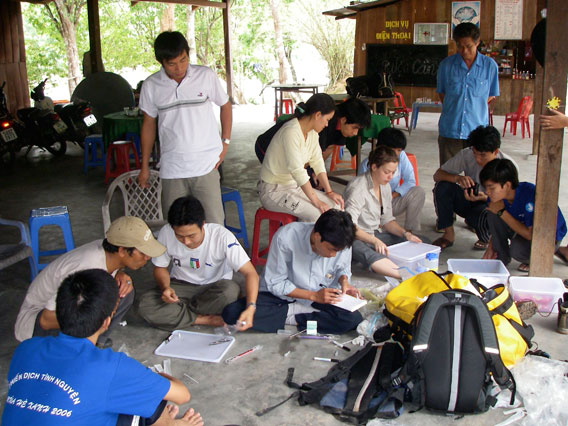
An Amphibian Training Course in Southeast Asia. Photo by: Jodi J. L. Rowley/Australian Museum.
Mongabay: You’ve done a number of training sessions with young scientists in Southeast Asia. Why is it important to aid science in these countries?
Jodi Rowley: It’s important to get younger generations all over the world passionate about biodiversity, particularly their local biodiversity. Often students just haven’t spent much time in the forest, and haven’t realized how amazing amphibians are—so the first step is just getting students into the forest, and hopefully they’ll fall in love with the place and the creatures within on their own. I hope that my enthusiasm is catching, too! Also, students often don’t realize that you can make a career in conservation biology or wildlife research. It’s not the most financially rewarding career but it’s so much more rewarding in other ways, and certainly a career that we need more Southeast Asian students to pursue.
Mongabay: You’ve had a lot of success in your career to date, what advice would you give students interested in wildlife conservation and research?
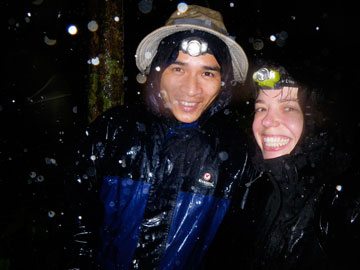 Rowley in Vietnam. Photo by: Jodi J. L. Rowley/Australian Museum. |
Jodi Rowley: Most importantly, you need to have a passion for nature and its conservation. It’s the passion that will carry you through the tough times in the field, and the hours in the lab. You need to be inspired and enthused enough by deciphering the ecological requirements of a species, or finding a previously undescribed species that you’ll sit in the rain for hours covered by leeches, traverse raging streams, and sort through hundreds of samples for days on end. Luckily for me, the magical moments more than make up for the difficulties.
I also think you need to be proactive about chasing opportunities. You can’t just wait for opportunities to come by, you need to actively seek them out.
Mongabay: Why do we need more herpetologists?
Jodi Rowley: Sometimes it is hard to pry students interested in wildlife conservation away from the large, charismatic animals like tigers and bears. There are some amazing mammals in Southeast Asia, many of which are in a lot of trouble, and need help, but overall amphibians as a group are more threatened than mammals or birds. That’s one of the reasons that I chose to become a herpetologist (although I tend to stick with amphibians rather than reptiles).
Mongabay: What’s next for you? Any special projects we should be aware of?
Jodi Rowley: I hope to continue discovering and documenting the amphibian diversity of Southeast Asia with my colleagues and students, and working towards long-term amphibian conservation in the region. I’m excited to be heading back in the field again soon this coming wet season!
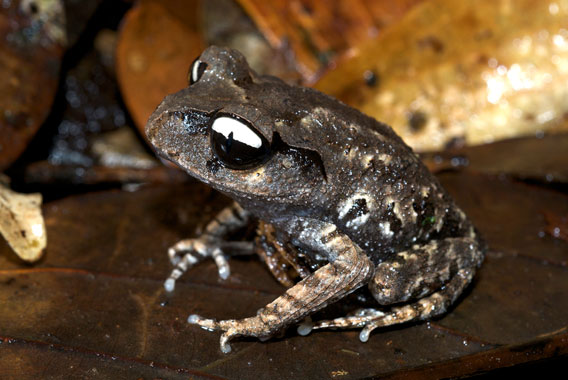
Leptobrachium leucops: a new species from Vietnam discovered by Rowley and colleagues in 2011. Photo by: Jodi J. L. Rowley/Australian Museum.
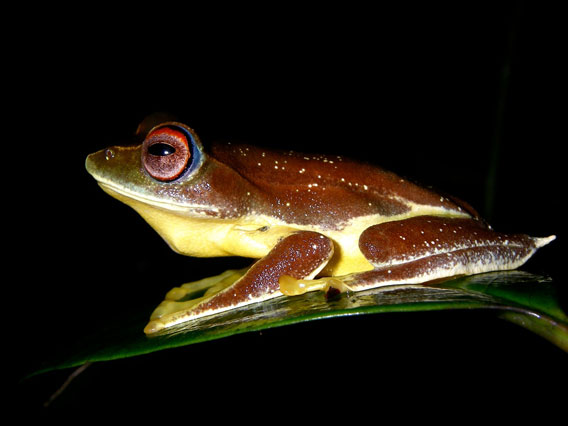
Rhacophorus chuyangsinensis, a related species to the vampire flying frog. Photo by: Jodi J. L. Rowley/Australian Museum.
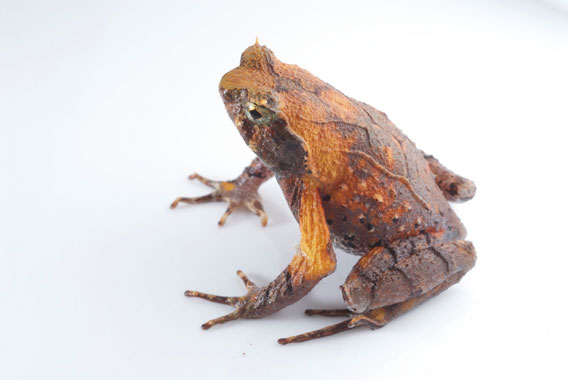
A species in the Ophryophryne genus from Vietnam. Photo by: Jodi J. L. Rowley/Australian Museum.
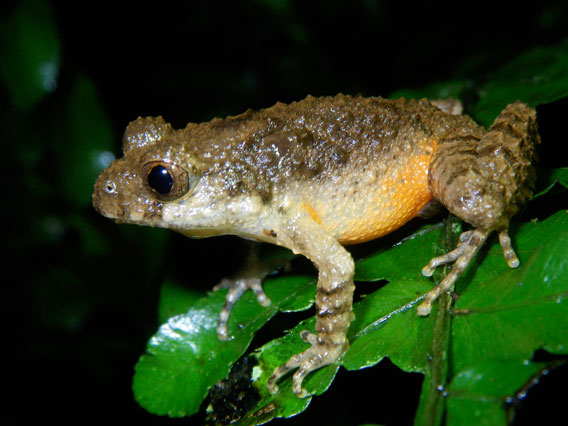
Leptolalax croceus: discovered by Rowley and colleagues in Vietnam in 2010. Photo by: Jodi J. L. Rowley/Australian Museum.
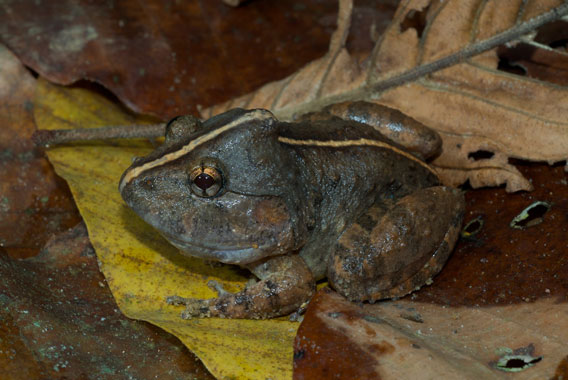
Limnonectes dabanus is only found in Vietnam. The IUCN Red List categorizes this species as Data Deficient. Photo by: Jodi J. L. Rowley/Australian Museum.

Leptolalax melicus was discovered by Rowley and colleagues in 2010. Photo by: Jodi J. L. Rowley/Australian Museum.
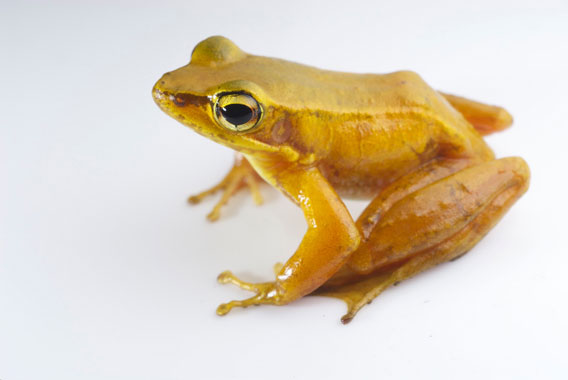
Odorrana khalam is found in Laos and Vietnam. The IUCN Red List categorizes this species as Data Deficient as well. Photo by: Jodi J. L. Rowley/Australian Museum.
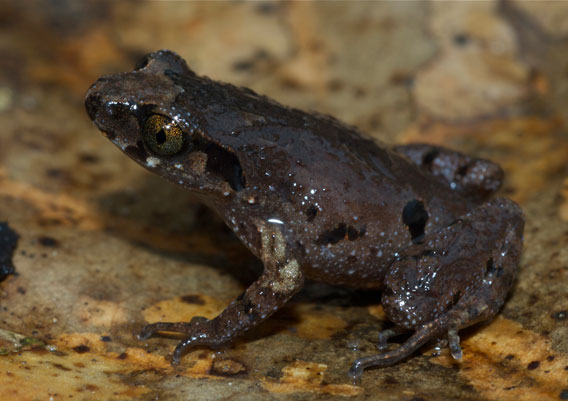
Leptolalax applebyi was discovered by Rowley and colleagues in 2009 in Vietnam. Photo by: Jodi J. L. Rowley/Australian Museum.
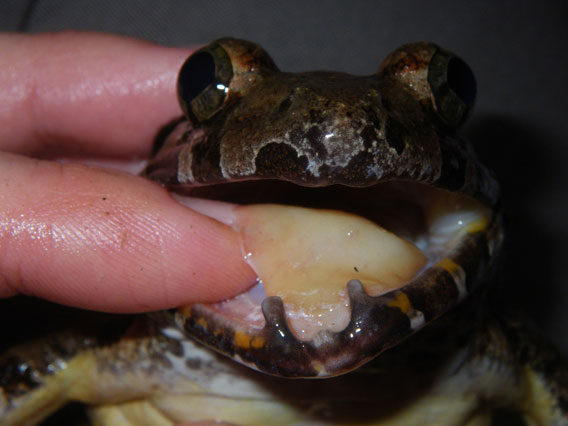
The fangs of Limnonectes poilani, Vietnam. Photo by: Jodi J. L. Rowley/Australian Museum.
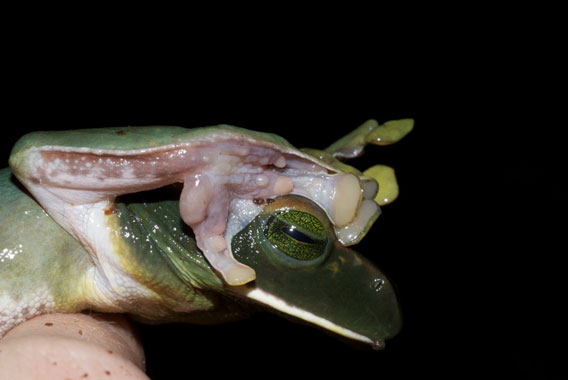
The defensive posture of Rhacophorus feae in Vietnam. Photo by: Jodi J. L. Rowley/Australian Museum.
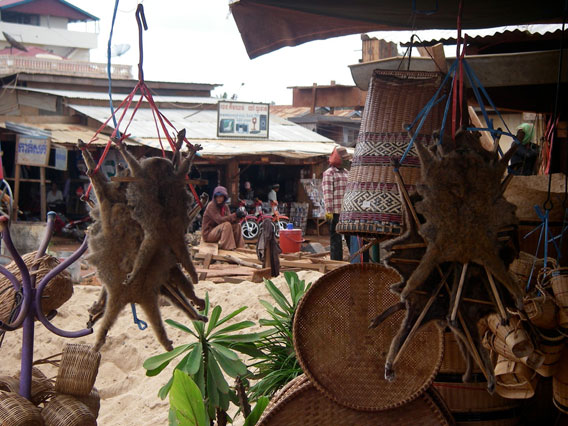
Bushmeat trade in Southeast Asia impacts more than frogs. These are slow lorises for sale in Cambodia. Photo by: Jodi J. L. Rowley/Australian Museum.
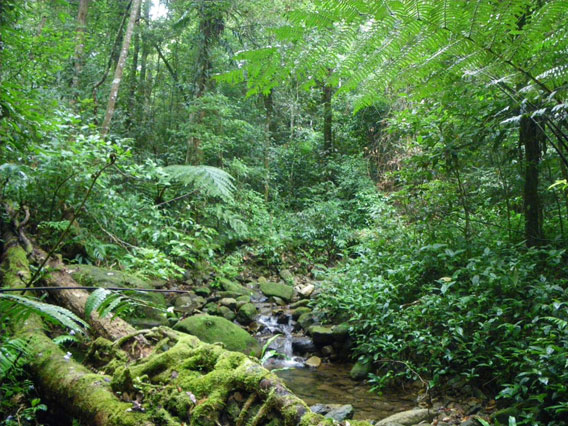
Forest in Kon Tum Province in Vietnam. Photo by: Jodi J. L. Rowley/Australian Museum.
Related articles
New species of frog sings like a bird
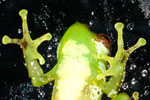
(12/12/2011) If you’re trudging through the high-altitude rainforests of northern Vietnam and you hear bird song, you might want to check the trees for frogs. Yes, that’s right: frogs. A new species of tree frog has been discovered in Vietnam that researchers say has a uniquely complex call that makes it sound more like a bird than a typical frog. Discovered in Pu Hoat Proposed Nature Reserve, the new species, dubbed Quang’s tree frog (Gracixalus quangi), dwells in the forests at an altitude 600-1,300 meters (nearly 2,000-4,265 feet).
Photos: two new paper clip-sized frogs discovered in Vietnamese mountains
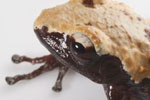
(12/07/2011) Researchers have discovered two new frog species living in the montane tropical forests of Vietnam. Known as moss frogs, these small amphibians employ camouflage as one way to keep predators at bay, in some cases resembling the moss that gives them their name.
Frog perfume? Madagascar frogs communicate via airborne pheromones
(01/25/2012) Researchers have found that some frogs in Madagascar communicate by more than just sound and sight: they create distinct airborne pheromones, which are secreted chemicals used for communicating with others. A paper published in Angewandte Chemie International Edition relates that some male members of the Mantellinae family in Madagascar use large glands on their inner thighs to produce airborne pheromones. Interestingly, the pheromones are structurally similar to those produced by insects. Scientists have identified frogs producing water-borne pheromones before, but this is the first instance of airborne.
Photos: 46 new species found in little-explored Amazonian nation
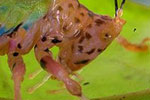
(01/25/2012) South America’s tiniest independent nation still hides a number of big surprises: a three week survey to the sourthern rainforests of Suriname found 46 potentially new species and recorded nearly 1,300 species in all. Undertaken by Conservation International’s (CI) Rapid Assessment Program (RAP) the survey found new species of freshwater fish, insects, and a new frog dubbed the “cowboy frog” for the spur on its heel. While Suriname may be small, much of its forest, in the Guyana Shield region of the Amazon, remains intact and pristine. The Food and Agriculture Organization (FAO) estimates that 91 percent of Suriname is covered in primary forests, however this data has not been updated in over two decades.
Scientists discover over 19,000 new species in 2009

(01/19/2012) In 2009 researchers described and named 19,232 species new to science, pushing the number of known species on Earth to just under two million (1,941,939 species), according to the State of Observed Species (SOS). Discoveries included seven new birds, 41 mammals, 120 reptiles, 148 amphibians, 314 fish, 626 crustaceans, and 9,738 insects.
New frog trumps miniscule fish for title of ‘world’s smallest vertebrate’
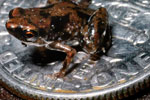
(01/12/2012) How small can you be and still have a spine? Scientists are continually surprised by the answer. Researchers have discovered a new species of frog in Papua New Guinea that is smaller than many insects and dwarfed by a dime. The frog trumps the previously known smallest vertebrate—a tiny fish—by nearly 1 millimeter.
(01/03/2012) The chytrid fungus, which is responsible for the collapse of numerous amphibian populations as well as the extinction of entire species, has been located for the first time in India, according to a paper in Herpetological Review. Researchers took swabs of frog in the genus Indirana in the Western Ghats and found the killer fungus known as chytridiomycosis.
The dark side of new species discovery
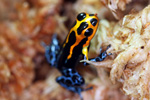
(12/21/2011) Scientists and the public usually rejoice when a new species is discovered. But biologist Bryan Stuart has learned the hard way that the discovery of new species, especially when that species is commercially valuable, has a dark side-one that could potentially wipe out the new species before protections can be put in place. Stuart has discovered 27 species unknown previously to scientists – so far. That includes 22 species of frogs, three types of snakes, and two salamanders. His experience with one of these, a warty salamander from Laos with striking markings (Laotriton laoensis), opened his eyes to a dark side of scientific discovery: commercial overexploitation before protections are in place. Shortly after Stuart described the previously unknown species Paramesotriton laoensis in a scientific paper published in 2002, commercial dealers began collecting this Lao newt for sale into the pet trade. In essence, the dealers used Stuart’s geographic description in the paper as a “roadmap” to find the rare newt.
Herpetology curator: behind-the-scenes of ‘new species’ discoveries
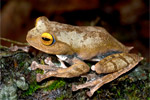
(12/18/2011) Bryan Stuart’s mission as a curator of amphibians and reptiles at the North Carolina Museum of Natural Sciences is to understand the diversity of life on earth. For that, he documents what species occur where and why. He’s particularly attracted to areas where there’s a dearth of knowledge, like Laos, Cambodia, Vietnam and Gabon, and so far has discovered 27 species unknown previously to scientists: three species of snakes, two types of salamanders, and 22 kinds of frogs.
Smelly frogs may be key to fighting antibiotic-resistant infections
(12/01/2011) Foul smelling frogs may save lives, according to new research in the Journal of Proteome Research. Examining nine species of Chinese frogs, known as “odorous” frogs for their off-putting smell, researchers have discovered an astounding variety of antimicrobial peptides, or put simply bacteria-killers.
Extinct frog rediscovered in Israel
(11/21/2011) After its marshland was drained, researchers thought the Hula painted frog (Discoglossus nigriventer) had vanished for good. However a patrol at the Ha-Hula lake in Israel recently discovered a single female amphibian that turned out to be the long-lost, and long-sought, Hula painted frog.
Museum specimens reveal the tracks of an amphibian epidemic
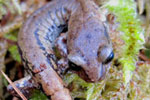
(11/07/2011) Dead men tell no tales, but dead frogs can speak volumes. Scientists have shown that frogs and salamanders preserved in museums tell the history of a deadly fungus and its spread across Mexico and Central America. The new finding, published recently in the Proceedings of the National Academy of Sciences (PNAS), may help explain past and ongoing amphibian die-offs in the region.
New site is a match-maker for world’s endangered frogs
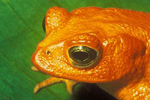
(11/03/2011) A new initiative by the conservation group, Amphibian Ark, hopes to match lonely, vanishing frogs with a prince/princess to to save them. Dubbed FrogMatchMaker.com after online dating sites, the program is working to connect supporters and donors with amphibian conservation programs in need. Currently, amphibians are among the world’s most imperiled species with 41 percent threatened with extinction according to the IUCN Red list.